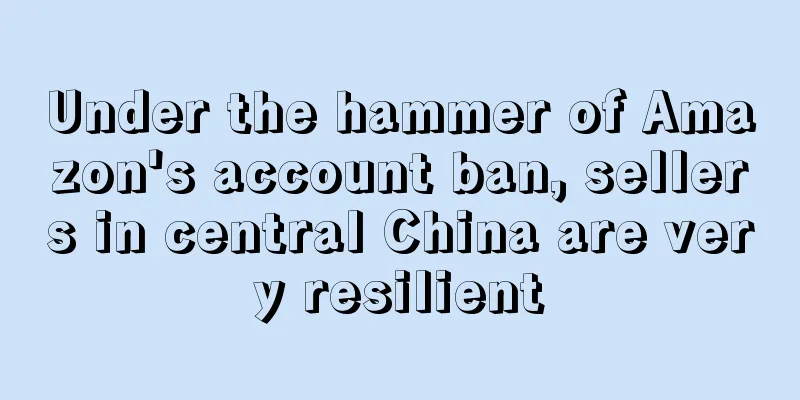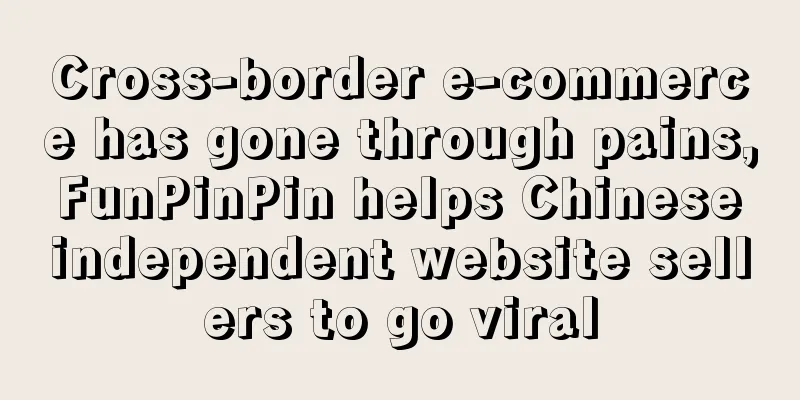Under the hammer of Amazon's account ban, sellers in central China are very resilient

|
Under the background of the upgraded control of third-party platforms, many sellers in Guangzhou and Shenzhen were affected by the suspension of their accounts and suffered heavy losses. In contrast, the sellers in the middle of the cross-border e-commerce industry were not significantly affected. They operated in compliance with regulations, worked hard, and their performance increased steadily. They are expected to gain opportunities to overtake others in the new round of reshuffle.
At the same time, some excellent independent site sellers in the central region are also rising rapidly. They are actively developing different business models and exploring stable long-term growth opportunities.
Whether it is a third-party platform or an independent site, some mid-region sellers represented by Jikeyin and Zhiou are occupying a pivotal position in the cross-border e-commerce industry.
Sellers in Guangzhou and Shenzhen are suffering from account suspension, but sellers in central China are “indifferent”?
This year has caused sellers in the cross-border e-commerce industry to think deeply. With the upgrading of third-party platform management, many sellers on these platforms have felt unprecedented pressure. In particular, Amazon’s crackdown on fake reviews has caused a wave of top sellers to fall from the top to the bottom.
Since the end of April, the accounts of top domestic sellers have been blocked one after another. Most of these blocked sellers are from Guangzhou and Shenzhen. Compared with the dire situation of some Guangzhou and Shenzhen sellers, some sellers in central China are relatively calm. Ennet talked to several cross-border companies in Zhengzhou, Henan, and dug deep into the real situation of sellers in central China under the background of account blocking this year.
As a well-known seller in the industry, Zhiou Home Technology Co., Ltd. (hereinafter referred to as Zhiou) is mainly engaged in the research and development, design and sales of its own brand home furnishings, including home furnishings, furniture, pets and garden supplies. Its three own brands, SONGMICS, FEANDREA and VASAGLE, are sold well around the world through platforms such as Amazon and eBay, of which the sales on the Amazon platform account for about 70%.
Amid the wave of account closures, a large number of sellers are wailing, but Zhiou welcomes compliance. Zhang Liuming, the company's marketing director, said that this year the platform is rectifying comment violations, which many people think is a challenge, but in fact, Zhiou welcomes this matter. Because before the wave of account closures, Zhiou has always been very rigorous in compliance and has never had any comment violations. So now, whether it is account closures or European VAT taxation, we think this is a positive direction for the industry. To a certain extent, this is a recognition and support of the platform for compliant companies, and the industry will become more and more sustainable in the future.
Zhengzhou Yilianke E-Commerce Co., Ltd. (hereinafter referred to as Yilianke), also located in Henan, has only one account in the world. Yilianke mainly deals in beauty and nail products. It is an enterprise incubated by Henan Postal Industrial Park. Since entering Amazon in 2018, it has achieved a three-fold annual sales growth.
Last year, the epidemic brought opportunities to Yilianke. The beauty and nail products were classified as necessities, and a large amount of offline traffic was transferred to online, which brought a great increase to Yilianke. This year, Yilianke still maintained a stable growth despite the account closure. Speaking of the account closure, Wang Quan, the operations director of Yilianke, said: "Our company has not been affected because we always adhere to the 'three no's': no inferior products, no small cards, and no fake orders."
Not involving platform violations may be the biggest advantage of central sellers this year. In other aspects, the advantages of central sellers are also reflected to a certain extent.
Amid the wave of account bans this year, some cross-border companies in Guangzhou and Shenzhen have reported layoffs, especially some larger companies, which have suffered severe losses and have laid off hundreds of people. Some companies have even directly laid off an entire team.
Some time ago, an industry insider broke the news that a group of people in a certain company was poached by a competitor. In this year's environment, this has a significant impact on a company, and this is what is happening. In the coming year, some cross-border companies in Guangzhou and Shenzhen will see even larger-scale personnel turnover.
Wang Xingyu, general manager of Henan Haiqi Information Technology Co., Ltd. (hereinafter referred to as Haiqi), said that one of the advantages of sellers in the central region may be the company's personnel, which is mainly reflected in the following points: 1. Relatively low personnel costs; 2. It is possible to find suitable talents. There are many talents in the cross-border industry in Guangzhou and Shenzhen, but the demand of employers is also large. On the contrary, there are certain talents in Zhengzhou, Xi'an, Nanjing and other places, but there are not many corresponding companies. 3. The personnel are relatively stable. Relatively speaking, the personnel of seller companies in the central region do not change jobs easily, and the stability of personnel can form long-term accumulation.
Stable personnel and compliant operations are the accumulation of power for long-term operation and are also the advantages of mid-level sellers. Looking at several mid-level sellers, they all have different operating methods in this special year, and one of their core goals is to maintain profits.
Maintaining profits, middle sellers continue to maximize the flywheel
Wang Quan, operations director of Yilianke, said self-deprecatingly: "Our operation model is the most primitive. We don't fake orders or conduct reviews. This way, we can develop more steadily and accumulate accounts continuously. Our advantage is that we are the early bird that flies first. Our overall sales have maintained steady growth this year."
With the combined effects of falling exchange rates and lower freight rates, Yilianke has minimized the impact of declining profits by leveraging its product category advantages. Compared with some sellers in Guangzhou and Shenzhen who are losing money, some sellers in central China, such as Yilianke, have shown strong resilience.
"Because of the increase in logistics and raw material prices this year, our profits have been compressed, but the profit cost accounts for a limited proportion in the entire product system, because we are making branded and high-premium products. The premium comes from the building of brand power. If there is pressure on both the logistics and supply chain ends, the product may not have any profit, but it does not have much impact on our products." Wang Quan said.
In the face of profits, sellers in the central region are also more practical in their operations. Dong Jiaxing, co-founder of Henan Aoyi Electronic Technology Co., Ltd. (hereinafter referred to as Aoyi Electronic), mentioned that profits must be guaranteed in order to survive in the long run.
Dong Jiaxing further introduced: "Involution has existed since I entered the industry. At least 90% of the sellers we meet on Amazon are Chinese. Everyone has a common mindset, not competing on product quality but on price. This year, there is a particularly popular product strategy - the spiral strategy. Product spiral promotion can quickly get orders, but whether it can make money later is another matter. Since the beginning of this year, many sellers will face a direct reduction in profits due to the European tax reform. At that time, I thought that prices should rise, but I didn't expect that prices would be reduced. We can't force our competitors to do anything, we can only change ourselves. For example, for similar products, I will lose money if I compete on price, so I compete on quality and have customers who really care about quality."
The price war among Amazon sellers this year is related to the account suspension trend. Under normal circumstances, some fake orders in previous years cannot continue, and many sellers have to rely on price to maintain rankings and sales, but this will not last long.
I have seen many sellers in a category who are the first in the category. When the second and third sellers lower their prices, they must feel uncomfortable to see themselves being surpassed. They know that their competitors are not as good as their own, but they still bite the bullet and compete on price. One day, a situation will arise: maybe no one can continue to do business. Dong Jiaxing said.
Competition among platform sellers has intensified. In addition to internal reasons among domestic sellers, factors from overseas cannot be ignored.
"The changes in the entire industry this year may be greater than we imagined. The reason for such changes is that everyone will see more information about platform rectification and competition among sellers. In fact, the key point of this issue comes from the decline in U.S. consumption capacity." Wang Xingyu introduced.
Wang Xingyu believes that the decline in the spending power of money directly affects purchasing power. The United States itself is in the shape of a spinning top, with a large middle layer, but under the epidemic, it is possible that many of the middle layers will sink to the bottom, and the spending power will decline at this time. The product price positioning of different sellers may have two different paths. To a certain extent, the sales of products with high customer unit prices have been affected, but this is actually a paradox. As a cross-border seller, if you want to grow bigger and make more and more profits, you must have a high customer unit price.
When third-party sellers develop to a certain stage, growth is an inevitable stage. Because platform economy is an economy of scale, why can Amazon become so big? Because it is an economy of scale. Only after it becomes big can it have a say and use the flywheel to drive many things.
The same is true for sellers. Amazon has used its flywheel overseas to leverage the efficient and low-cost supply chain resources in China, and has also driven a lot of resources including human resources and logistics. As a platform seller, only growth can make your flywheel bigger and bigger. If you don’t grow, your competitors will, or sellers with financial backgrounds will. What ultimately makes a company successful is often not the business model, but some ecosystems, which for sellers may be the supply chain ecosystem around them.
On the road of continuous development, we see that the third-party platform has upgraded its control, and some sellers in the central region are also opening up new channels. Wang Xingyu mentioned that whether it is other platforms or independent sites, they are all business channels for sellers. Combined with their own situation, after careful consideration, multiple platforms and independent sites will be the future development direction of sellers.
30% of sellers have already laid out their plans. It is the right time to start building an independent website.
Recently, Ebang Think Tank surveyed about 300 cross-border enterprises and found that independent websites have become one of the main overseas expansion models, with 31% of enterprises having independent websites. Among the enterprises that have not established independent websites, 21% are preparing to build websites to implement the DTC model, 47% of enterprises said they would not consider building websites, and another 32% are waiting and watching.
Among the companies that have independent websites, 31% of them have independent website sales accounting for more than 30% of their total sales, and 3% of them rely entirely on independent websites for sales. For 46% of the companies, independent website sales account for 10%-30% of their total sales.
Sellers in central China are also exploring independent station channels, and some have achieved good results.
The company's Amazon and independent website businesses run in parallel, and Wang Xingyu recognizes the development trend of independent websites. He believes that compared with platforms such as Amazon and AliExpress, sellers running independent websites have different customer groups and different competitors, which is a new track.
Henan LanGu Technology took the lead. Zhao Wenzhong, the project leader of the company's independent website, said that considering the decline in sales on third-party platforms and the rising popularity of independent websites, LanGu Technology started to build an independent website in 2018. After several attempts, it finally gained a foothold in the market segments of story accessories, children's dresses and size-free underwear.
Regarding the old saying "Can platform sellers build independent websites?", Zhao Wenzhong believes that it is still a good time to enter the independent website market. One of the decisive factors in whether the project can be completed is whether the boss is determined. If the boss decides to do it, he needs to provide all support such as recruiting an operation team, products and funds; if the boss just wants to try it out, it is not recommended.
Transformation is not easy, and enthusiasm alone is not enough to achieve success. "Burning money" is inevitable. The company must support the independent station department to survive for at least 6 months, give it enough time to grow, and understand the profit cycle of the independent station. It is difficult to achieve it if expectations are too fast.
Many people give up gradually because they see no hope. If the data shows improvement after the investment, such as higher ROI and effective repeat purchases, sellers can further determine whether to increase investment or terminate the business based on the data. Whether a business can succeed in the end depends on the team's practical skills, the company's courage and luck.
As transformation becomes a trend, should independent websites take profits or give up profits?
Among independent website sellers, the transformation from the blockbuster model to the vertical category has become a trend.
Zhao Wenzhong introduced that the success rate of discovering hot products is less than 0.2%, and the testing cost is very high. Even if you make money by discovering a hot product, it may not be worth it to invest this profit in discovering a second hot product.
Since the hit model has no user retention and repurchase, the company's cash flow is not optimistic. If illegal products are made, the payment channel is also prone to problems. Once the bottleneck is blocked, the company's business will be difficult to continue. For this reason, many sellers have begun to turn to formal operations.
Wu Jiayang, founder of Chuanliu, believes that the transformation of the explosive model to vertical categories is a major trend. The direct reason is that most of the previous explosive products were illegal products, and this model violates the policies of major traffic channels.
Since the first half of the year, a large number of advertising accounts have been rectified, and the account blocking has continued . It has not stopped since September, and it was particularly serious around Black Friday. Wu Jiayang introduced that there are two main reasons for account blocking: business blocking (such as product violations) and technical blocking (such as frequent IP changes due to lack of operation). The former is difficult to appeal, while the latter can most likely get the account back by submitting identity information and an appeal letter.
Sellers are transforming faster, but Wu Jiayang does not think that sellers with hit products can successfully transform. "Many of our customers used to sell hit products, and it is difficult for them to give up their original thinking. It takes a certain amount of time to make a return on vertical independent sites, but they may lose patience and determination if they don't see returns in two weeks. This is the most common problem. In addition, from a practical perspective, they are used to launching single pages and are not very good at operating a complete website."
Chen Zhen, deputy general manager of new business development at Facebook, believes that the difficulty for sellers to transform lies in: First, the concept. If sellers want to build an independent website from the platform, or switch from a hot-selling product to a brand website, the biggest difference is whether to make a profit or give up a profit in the short term. The hot-selling model and platform sales are to make as much money as possible, but to build a brand, you may only keep a certain profit (such as 10%), and the rest of the profit will be given up, and it is difficult to change to the mindset of giving up a profit. Second, sellers are increasingly strict in controlling the supply chain, delivery time, and product quality. It is not enough to be good at only supply chain or delivery. Sellers balancing supply chain and delivery may be a factor in successfully building a brand and making a profit.
So which sellers are doing better in vertical sites?
Wu Jiayang said that in several circles in Hangzhou, people discussed that the first bonus of cross-border e-commerce is traffic, and the second is product bonus, which is based on products. First, your product must be excellent, and second, your product must bring its own traffic to ensure profits. In this wave of independent websites, no matter which sub-industry they are in, they have all put a lot of effort into product research and development, design, and production. Among them, the most representative are manufacturing sellers.
Unlike the sellers who passively transform into hot sellers, sellers in the manufacturing industry have the ability to develop products and continue to innovate. "We have seen crazy growth in this type of sellers this year. For example, Lechuang, their independent website has grown very well this year, and next year's financial report will be even more impressive, which should be several times higher than this year's."
In addition to winning with products as the core competitiveness, Wu Jiayang believes that sellers can also look for dividends in subcategories. In addition, they can also consider emerging markets. For example, since the epidemic, sales in Southeast Asia are recovering, and the Japanese and Korean markets are also good. In the short term, advertising policies in the Middle East, Eastern Europe, Africa and other regions are relatively loose, and there are also some traffic dividends.
Can sellers enter emerging markets? You can refer to the opinions of Jikeyin, which is a big seller on Southeast Asian independent websites.
It is not advisable to rush into emerging markets
Recently, Southeast Asian e-commerce platform ZALORA released the "2021 Southeast Asian Trend Report", which stated that according to Google data, Southeast Asia has added 40 million Internet users this year. At present, the Internet penetration rate in Southeast Asia has reached 75%, and eight out of ten Internet users will shop online.
Jikeyin VP Guo Xinhua said that the development of e-commerce in Southeast Asia is relatively lagging behind, and whether it is logistics maturity, payment maturity or online e-commerce penetration, they are all at a relatively low starting stage. With the catalysis of the epidemic in the past two years, users in Southeast Asia have gradually shifted to e-commerce shopping. After the epidemic, Southeast Asian e-commerce as a whole will have very rapid development and great room for growth.
Unlike the monopoly of domestic e-commerce platforms, Southeast Asian e-commerce is more diversified. There is overlap between users of third-party platforms and independent sites, but there are obvious differences in the user portraits of the two.
When opening a store on the platform, whether it is a traffic-generating model or a marketing model, user conversion is more based on low prices. Users compare prices from three stores to check the price-performance ratio. This is the attribute of young users. However, independent sites have certain product thresholds from product selection to operation and promotion, and then to product delivery.
Guo Xinhua said: "The threshold of our products is relatively high. In this era where goods find people, it is also costly to acquire customers through advertising and marketing. Therefore, our entire product is basically mid-range in terms of category and product. The main users of this type of product are definitely working people with relatively strong purchasing power."
Therefore, the core users of Jikeyin in Southeast Asia are not particularly young people (such as those under 25 years old), but middle-aged people over 25 or 30 years old. This type of users has stronger economic strength and pays attention to comprehensive dimensions such as product quality in addition to product cost performance. At the social e-commerce level, Jikeyin, which uses the COD model, focuses on single product promotion. This strategic positioning clarifies the established differences between its user population and platform users.
When analyzing emerging markets, Southeast Asia is often mentioned as an excellent example. So is this market suitable for novice sellers?
Guo Xinhua analyzed that as the epidemic has become normalized, the income of local people in Southeast Asia has still been affected to a certain extent. People will be more rational and even control the proportion of daily consumption expenditure. Entering Southeast Asia at this time will particularly test the company's organizational and cost control capabilities.
"If you don't have your own core competitiveness, I think it will be difficult to enter the market and generate profits to a certain extent. It is still quite arduous. First, the epidemic will affect your receipt, and second, costs are also rising, such as raw materials and freight. If a new seller comes in and the volume is small, such as 5,000 or 10,000 orders a day, in fact, in the current e-commerce link, you don't have your own moat.
If you are not strong enough, can you get better procurement costs, advertising costs and logistics costs by cooperating with suppliers, advertisers and logistics companies? If you don’t have such a core competitiveness, you will lose a lot to others in terms of cost. In addition, if you don’t understand the offline cultural systems and political factors of various countries, and if the signing rate is not guaranteed, I think it will be difficult for you to make much money, let alone gain a foothold. This is a big challenge. ”
Even if they follow the trend and find a hit product, with 300 to 500 orders a day or 300 to 5000 orders a day, sellers still have to consider sustainability, that is, whether they can maintain the scale advantage. In the field of COD e-commerce in Southeast Asia , it is difficult to have a certain core competitiveness without scale advantages, and scale determines costs.
"If you are a small business, or you want to make a small investment and then withdraw, I don't think it is suitable. After entering, I think you should think more about your core competitiveness. If you think you can have certain advantages in this market, then I think it may be an opportunity." Amazon Central Sellers Independent website |
<<: Instagram releases 2022 Annual Report, the latest trends in beauty and fashion are here
>>: Etty will hold promotional activities after Christmas. Is it to boost year-end performance?
Recommend
When is Prime Day this year? The authoritative prediction is released!
When will the long-awaited Prime Day be held on A...
The price of ocean freight will continue to rise next week!
The tide of logistics price increases continues! ...
What is Pluang? Pluang Review, Features
Pluang is a fintech app that specializes in digit...
64-year-old auntie is trending on the Internet, and her cave wig is praised by the world
It is very difficult for rural women to be financ...
Innovative digital flexible supply chain "SHEIN model" for digital transformation of traditional industries
With the development of Internet infrastructure a...
Salesforce Survey: North American Online Consumption Data for Q1 2021
U.S. online retailers ended the quarter on a stro...
In order to "hunt down" users who give bad reviews, some Amazon sellers are doing everything they can!
Foreign media reported that most of the goods on ...
What is ASOS Marketplace & ASOS Marketplace Review
ASOS Marketplace is a C2C fashion auction market ...
Many big sellers rushed into the market, and ChatGPT exploded!
In 2023, ChatGPT became extremely popular, and ma...
Hundreds of Shopify merchants’ data leaked: California man sued
California resident Tassilo Heinrich was arrested...
What is Taboola? Taboola Review, Features
Taboola was founded in Tel Aviv, Israel in 2007 an...
Indonesian e-commerce service company Jet Commerce to enter Malaysia
Oliver Yang, the company's founder and CEO , ...
TikTok has a new rival! Netflix launches "Fast Laughs" funny short video channel
According to techcrunch, Netflix officially launc...
With over 17 million monthly active users, Nykaa leads the Indian beauty e-commerce market
Affected by the epidemic, since 2020, Indian peop...
Amazon denies layoffs, says it's just a change in hiring plans
Amazon has denied reports of mass layoffs , sayin...









